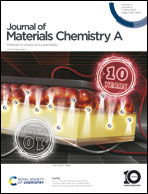Research progress on the construction of synergistic electrocatalytic ORR/OER self-supporting cathodes for zinc–air batteries
Abstract
Zn–air batteries (ZABs) have developed rapidly as novel energy storage devices to replace metal-ion batteries. However, the kinetics of the air-cathode is slow, and thus it is necessary to develop highly efficient and stable bifunctional catalysts. Generally, self-supporting electrodes can avoid the use of binder; moreover, the growth of the catalyst in situ on the substrate can improve the performance of ZABs. In this review, we systematically summarize the application of non-precious metal-based self-supporting electrodes in ZABs according to the recent research progress. Firstly, the basic structure and principle of ZABs, including Zn anodes, air-cathodes and electrolytes, are proposed. Subsequently, a reasonable electrode preparation method is discussed by combining the reaction mechanism of ZABs during the charging and discharging processes. The reaction mechanism is further discussed by combining operando techniques and theoretical calculations for a deep understanding of the real active sites, which lays the foundation for the directional synthesis of highly efficient self-supporting electrodes. Then, the application progress of self-supporting electrodes in ZABs is discussed, and it is proposed that the construction of hybrid cells is an effective means to promote battery efficiency. Finally, the challenges associated with ZABs and their future directions are presented and have a guiding significance for the rapid development of related fields.

- This article is part of the themed collections: Journal of Materials Chemistry A Recent Review Articles, 2023 Journal of Materials Chemistry A HOT Papers and 2024 Journal of Materials Chemistry A Lunar New Year collection


 Please wait while we load your content...
Please wait while we load your content...